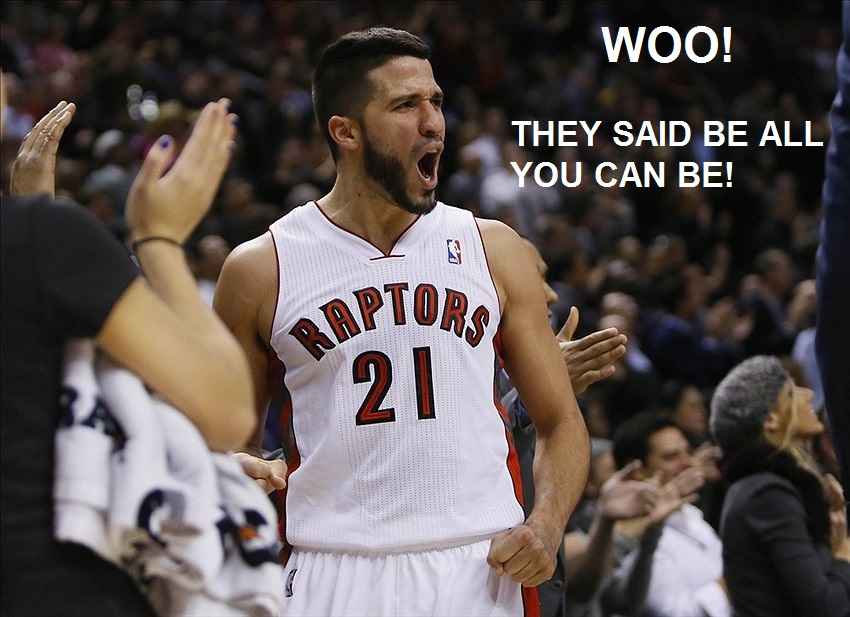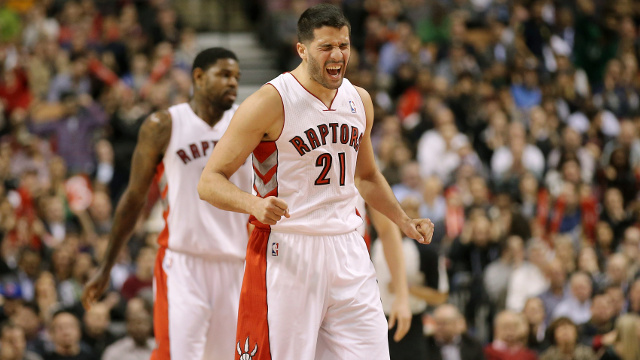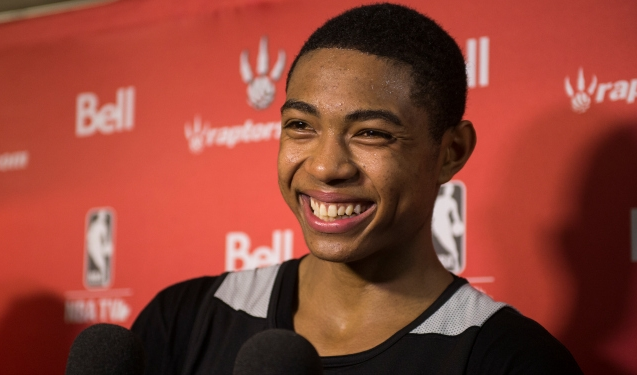My late-night two cents on the matter.
Late Wednesday night, it was reported that the Toronto Raptors and point guard https://www.raptorsrepublic.com/2014/07/10/3-reasons-greivis-vasquez-deal-makes-sense/Greivis Vasquez had agreed upon a 2-year, $13 million deal. From all accounts, it appears both years of will be fully guaranteed.
For critics of the move, resource allocation is the sticking point. Generally speaking, paying $6.5 million to the backup point guard isn’t good asset management, especially when he has a solid incumbent ahead of him in the lineup. With many other weaknesses on the roster, it could be argued that the Raptors’ limited resources should have been allocated elsewhere. With respect to that line of thinking, I really see no argument. It’s a lot of money.
There’s also the perspective that Vasquez’s play, onto itself, is not worth the money. Again, that’s not something I necessarily want to argue against either. While it’s true that Vasquez is a solid player, I doubt his on-court production dictates a lavish figure of $6.5 million. Vasquez posted a career high true-shooting percentage last season, yet his assist numbers dropped (which makes sense given the change in role), which yielded a league-average PER of 14. $6.5 million is a lot to pay for league average production, especially considering Vasquez’ play is likely worse than his PER given his defensive shortcomings.
But I do think this deal made sense for the Raptors. Here are three reasons.
1. He’s great in two-point-guard lineups with Lowry
This should be evident to whomever watched the Raptors’ playoff series against the Brooklyn Nets. With the Nets’ choosing to aggressively blitz pick-and-rolls, Vasquez’ ability to serve as a secondary ball-handler in 2PG lineups was the only counter the Raptors’ had. During the regular season, the two-man combo of Lowry and Vasquez posted a team-best +17.6 points per 100 possessions.
In part, the reason why the pairing works is because Lowry and Vasquez have complementary skills. Vasquez is taller, standing at 6-foot-6, which allows him to more easily thwart blitzing pick-and-roll coverages as he can pass over-top bigger defenders. It also works well because the two are both good ball-handler capable of driving and shooting threes. With the help of an effective screen to start the action, Vasquez or Lowry always have the option of making a point-wing pass to the other to set up one-on-one scenarios off the bounce. Ball-handling and therefore attacking off the dribble was something the Raptors’ lacked. Vasquez fills that need.
2. It’s a player, not a car
There’s a fallacy in the way some fans assess transactions in the NBA. It’s different from any other market.
For example, consider the purchase of a car. For the most part, you look around at various websites, you visit dealerships, you weigh pros and cons and ultimately, you take the best deal on the table. That’s how the marketplace works, where competition leads to an optimal outcome.
The player market isn’t nearly as abstract. It’s different because they’re less interchangeable. Some fundamental aspects are the same, in that you do your due diligence, look up his stats, watch some film, talk to his coaches, and make an informed decision, but for the most part, there’s only one player that really fits each need. Every car can drive you to work. Not every player can fit on your team.
It can be argued that for the price, Vasquez isn’t the best fit. But considering his play last season, especially down the stretch when his health improved, it’s hard to argue that an upgrade could have come elsewhere, especially considering the Raptors were already over the cap. If Vasquez was let go, the money for his replacement would have come out of the exceptions, or via trade, both of which could have cost more. Essentially, the opportunity cost (what the Raptors are giving up) in retaining Vasquez was likely lower than any other option, and so they kept him.
3. Need vs. Luxury
Strictly speaking, the Raptors didn’t need to reinforce a position of strength. With Lou Williams and Kyle Lowry in place, next year’s team didn’t need any help at the point. Williams can handle the ball, and is a decent creator when pressed into duty. He’s a good option for 10 minutes a game at the point, which is really all he needed to provide with Lowry soaking up 32, and a third-string guy taking 6. The Raptors’ didn’t even need more help at the two, as DeMar DeRozan is a minute-sponge, ranking third in total minutes played last season. Plus, Williams can also play the two as well, albeit he’s undersized. There wasn’t a pressing need for Vasquez on the roster.
In that regard, Vasquez is a luxury, but luxuries aren’t bad. Not only does he provide an upgrade at the point and an alternative look with 2PG lineups, Vasquez also provides depth, both in terms of the team’s style of play and as injury insurance.
First, Vasquez gives the team a different look. Lowry and Williams are both great ball-handlers, but they’re undersized. Vasquez counters that dynamic by being big, while being able to handle the ball. Similarly, at the two, DeRozan is bigger, but can’t consistently hit threes and his handles are somewhat limited. Again, Vasquez provides a different look. It gives Casey more options and more counters to throw at opposing defenses.
And second, it’s good to have more depth on the roster as a hedge against injury. Lowry was great last season, but an under-appreciated aspect of achievements was his ability to avoid injury. With his hard-nosed style of play — driving into the paint, creating contact, drawing charges — Lowry is liable to get injured, and if he were ever to go down, the Raptors’ have a contingency plan in Vasquez, who can hold down the fort for stretches at a time.
To recap, the deal wasn’t necessarily good, nor bad. In the abstract, it’s an overpay for Vasquez’s abilities, but he fits a number of needs for the franchise, and serves as insurance. Like most transactions made by Ujiri, there was some good sense behind it.



